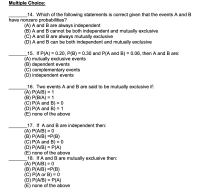
A First Course in Probability (10th Edition)
10th Edition
ISBN: 9780134753119
Author: Sheldon Ross
Publisher: PEARSON
expand_more
expand_more
format_list_bulleted
Topic Video
Question
I need help on this multiple choice question please: 14 to 18 please

Transcribed Image Text:14. Which of the following statements is correct given that the events A and B
have nonzero probabilities?
(A) A and B are always independent
(B) A and B cannot be both independent and mutually exclusive
(C) A and B are always mutually exclusive
(D) A and B can be both independent and mutually exclusive
15. If P(A) = 0.20, P(B) = 0.30 and P(A and B) = 0.06, then A and B are:
(A) mutually exclusive events
(B) dependent events
(C) complementary events
(D) independent events
16. Two events A and B are said to be mutually exclusive if:
(A) P(A/B) = 1
(B) P(B/A) = 1
(C) P(A and B) = 0
(D) P(A and B) = 1
(E) none of the above
%3D
%3D
_17. If A and B are independent then:
(A) P(A/B) = 0
(B) P(A/B) =P(B)
(C) P(A and B) = 0
(D) P(A/B) = P(A)
(E) none of the above
_18. If A and B are mutually exclusive then:
(A) P(A/B) = 0
(B) P(A/B) =P(B)
(C) P(A or B) = 0
(D) P(A/B) = P(A)
(E) none of the above
%3D
%3D
Expert Solution
This question has been solved!
Explore an expertly crafted, step-by-step solution for a thorough understanding of key concepts.
This is a popular solution
Trending nowThis is a popular solution!
Step by stepSolved in 2 steps

Knowledge Booster
Learn more about
Need a deep-dive on the concept behind this application? Look no further. Learn more about this topic, probability and related others by exploring similar questions and additional content below.Similar questions
- Sonia was asked to find the average of the following integers-19,-3,7,36. What answer should she come toarrow_forwardJavier surveyed 60 students about their favourite subjects in school. Here are the results. Favourite Subject Number of Students Mathematics 22 Science 16 Neither mathematics nor science 25 Determine how many students like only mathematics OR only science. Answer:arrow_forwardMrs. McCallister has 63 star stickers left at the end of the year. She shares these remaining star stickers equally amongst nine students in her classroom. How many stickers will three students get altogether?arrow_forward
arrow_back_ios
arrow_forward_ios
Recommended textbooks for you
 A First Course in Probability (10th Edition)ProbabilityISBN:9780134753119Author:Sheldon RossPublisher:PEARSON
A First Course in Probability (10th Edition)ProbabilityISBN:9780134753119Author:Sheldon RossPublisher:PEARSON

A First Course in Probability (10th Edition)
Probability
ISBN:9780134753119
Author:Sheldon Ross
Publisher:PEARSON
